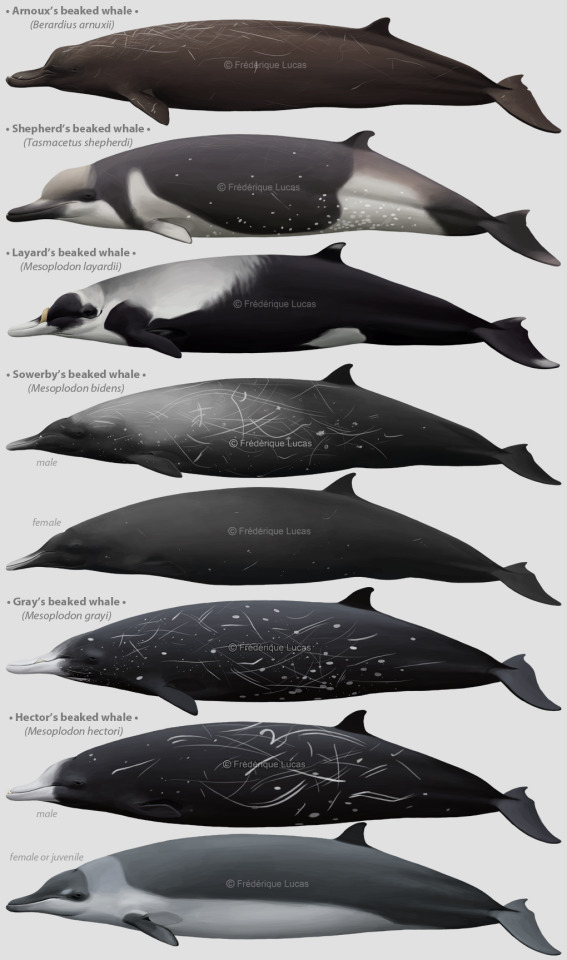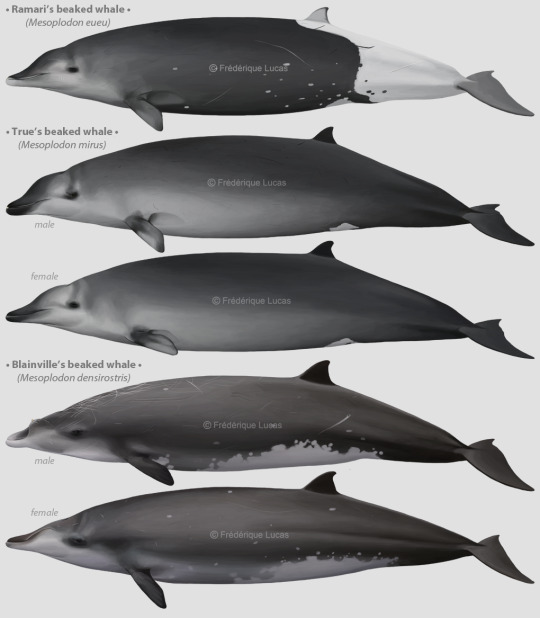#Tasmacetus shepherdi
Explore tagged Tumblr posts
Photo

Shepherd’s beaked whale Tasmacetus shepherdi
Observed by oscarkokako, CC BY-NC-ND
#Tasmacetus shepherdi#Shepherd's beaked whale#Cetacea#Ziphiidae#cetacean#whale#Oceania#New Zealand#Pacific Ocean
4 notes
·
View notes
Text
15th of September 2024: Shepherd’s Beaked Whale

Apologies for the blurry picture, but unfortunately this seems to be the best photo we have of Shepherd’s Beaked Whale (Tasmacetus shepherdi) when not stranded. Non-specialists have reported them to be up to 7 metres long, but we do have confirmed lengths of up to 6.6 m [1].
They live in the Southern Hemisphere at latitudes of around 30��S to 50°S, meaning that the few times they have stranded have been in South America, e.g. in Argentina, and in Southern Australia [2]. Outside of this, it can be hard to do more research on them, as they are deep sea whales [3], and the latitudes they’re at are notorious for harbouring particularly stormy sea weather [1]. Thus there’s no surprise that for 15 years (between 2002 and 2017) there were no sightings of them underwater, though the latter did give us a video [4].
We do still know a bit about them based upon the stranded individuals. For one, they are unique among beaked whales for having a full set of teeth in both their upper and lower jaw (most only have one or two pairs in the lower jaw). One stomach content analysis also found that in addition to the cephalopods which are a common component of the diet of beaked whales, they also eat fish [5]. Their teeth have also been used to estimate the age of one individual stranded in Punta Quilla in Argentina to be 23 years [6].
Sources: [1] [2] [3] [4] [5] [6] [Image]
#critter of the day#critteroftheday#marine life#whale#marine mammal#beaked whale#zoology#animal species#animal#animal facts#whale species
2 notes
·
View notes
Text
#2488 - Tasmacetus shepherdi - Shepherd's Beaked Whale

One last beaked whale from the Whanganui Regional Museum, but this one is extra-special - it's the holotype of a species discovered by the curator in 1937.
AKA Tasman's beaked whale or simply the Tasman whale. The only member of its genus, only seen alive four confirmed times, and very rarely stranded.
George Shepherd found the whale near Hāwera, determined it was something unusual, and had the by-then month-dead remains shipped to the museum, wrapped in disinfectant and cloth, and left them on the museum roof to finish breaking down. He wisely didn't inform the locals where the ungodly stench was coming from.
About halfway down the spine the vertebrae are deformed by a large lumpy growth, that was compressing the spinal cord and may have been the cause of death. Probably extremely painful, too.
Adults can reach lengths of 6 metres (20 ft) to 7.1 metres (23 ft) and weigh about 2.32 to 3.48 tons. At birth they may be about 3 metres (9.8 ft) long. Unusually toothy for a Ziphiid, possessing a full set of 17 to 27 pairs of teeth. This is probably because the species eats more fish than the usually squid-focused other beaked whales.
Whanganui Regional Museum, New Zealand
1 note
·
View note
Photo


A bunch of beaked whales
I did mention I got to paint a lot of beaked whales, right? ;) After the bottlenose whales here are, well, the others. I thought it was nice to put them all together, really makes you appreciate the wonderful diversity within this big family (and it saves you from ‘a beaked whale a day’ for the next 1.5 weeks). There’s too many to all discuss individually but I have some favourites:
Shepherd’s beaked whale was a joy to paint as they are one of my favourites. Their markings are so beautiful, and they are also unique in being the only beaked whale to have a full set of teeth. For very long their colour pattern was unknown (and oft presumed to have this streaky pattern) until in 2006(!) their real colouration was formally described. They are a beautiful, elegant and unique looking species.
Sowerby’s beaked whale provided a similar ‘aha’ erlebnis for me. Often illustrated as a medium gray throughout (which is certainly fitting for the females) some interesting photographs of adult males showed a rather distinctive light blaze between their blowhole and dorsal fin. In some males it was very subtle, but others had almost as much contrast as a Layard’s beaked whale - I chose to illustrate something in the middle. Very interesting and something I hope will be the subject of further study. Males and females also have funny white lips.
Ramari’s beaked whale can’t be overlooked as it is the youngest member of the family: only described three months ago, in October 2021. Previously known as the southern form of the True’s beaked whale, analysis proved they were a species all of their own. Very happy to have painted this one too, as the mysterious southern True’s with their shining white peduncles always intrigued me.
And lastly, I can’t not mention Blainville’s beaked whale because take a closer look at that snout. Any whale whose mouth somehow ends up above their eyes is worthy of an extra look I think. And the Layard’s beaked whale because they have always been my number 1 favourite beaker.
#illustrations#scientific illustrations#beaked whales#Ziphiidae#beaked whale#Arnoux's beaked whale#Berardius arnuxii#Shepherd's beaked whale#Tasmacetus shepherdi#Layard's beaked whale#Strap-toothed whale#Mesoplodon layardii#Sowerby's beaked whale#Mesoplodon bidens#Gray's beaked whale#Mesoplodon grayi#Hector's beaked whale#Mesoplodon hectori#Ramari's beaked whale#Mesoplodon eueu#new species#True's beaked whale#Mesoplodon mirus#Blainville's beaked whale#Mesoplodon densirostris#digital art
209 notes
·
View notes
Photo



339) Tasmanowal dziobogłowy, Shepherd's beaked whale, Tasman's beaked whale, Tasman whale (Tasmacetus shepherdi) – gatunek ssaka z rodziny zyfiowatych (Ziphiidae). Występuje w wodach przybrzeżnych i otwartych morzach wokół Nowej Zelandii, Argentyny i Chile. Tasmanowal dziobogłowy został odkryty dopiero w 1933 i od tego czasu obserwowano niewiele osobników tego gatunku. Do niedawna sądzono, że występuje on tylko w morzach oblewających Nową Zelandię, jednak w latach siedemdziesiątych stwierdzono jego obecność również u wybrzeży Argentyny i Chile. Wal ten zajmuje w swojej rodzinie szczególne miejsce ze względu na niezwykłe uzębienie: w żuchwie oprócz paru dużych zębów na przodzie znajduje się jeszcze co najmniej 12 mniejszych zębów, a ponadto około 10 par zębów w górnej szczęce. Wyglądem i zwyczajami przypomina pozostałe gatunki zyfiowatych. Prawdopodobnie żywi się głównie głowonogami i rybami.
0 notes